Electrical energy
Introduction
In Standard Four, you learnt how to generate electricity from waterfalls, the sun, wind and fuel. In Standard Six, you learnt how to generate electricity from biogas. In this chapter, you will' learn how water waves, water currents, and geothermal energy are used to generate electricity, You will also learn about the quality of renewable energy over non-renewable energy. The competencies gained Will enable you compare ways of generating electricity from water waves, water currents, and geothermal energy.
The concept of electrical energy
Electrical energy is generated from primary sources such as natural gas, biogas, wind, geothermal energy, coal, and water waves. Electrical energy is a so called an energy carrier, This is because it can be converted into other forms Of energy, such as mechanical energy heat energy, and light energy,
The concept of water waves
When the surface Of Still water is disturbed by a force Of something dropped from above, a change in the vertical motion Of the water molecules around that surface occurs, The directly affected water molecules oscillate up and down at the same position. This motion affects neighboring molecules. Thus, the water surface appears to have an undulating motion. It also appears to move away horizontally from the source Of the disturbance, In reality, water molecules do not move horizontally; but it is the water wave energy that moves.
| Material : basin, water, and a small Stone Procedure 1. Take a basin and fill water to three-quarters. 2.Drop a small stone on the surface of water as shown in Figure 1 image What happens to the water?  Fig. 1 A Pupil creating water waves |
Water waves in the ocean, sea, lake or dam are caused by wind. These occur due to the friction between the wind and the surface Of the water. The magnitude of the produced waves depends on the wind speed. Water waves are also caused by the rise or fall Of water level in the ocean. This is caused by the gravitational attractive force between the earth and the moon. This force causes water to move away or closer to the Shoreline. The movement of water away or closer to the shoreline is known as ocean tides. The movement away from the Shoreline is called a low tide and the movement closer to the shoreline is called a high tide as shown in Figure 2 (a) and (b).
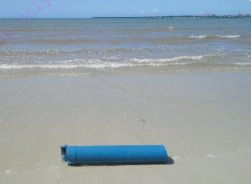 low tide | 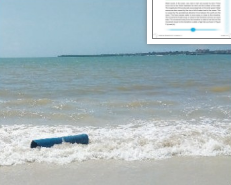 high tide |
Figure 2: Low and high tides
Besides producing large waves, tides also produce water currents, Both water waves and water currents produce mechanical energy that is driven from the forces exerted by water. Therefore, this energy can be used to generate electricity.
Generating electricity from water waves
Water waves caused by wind or the gravitational attraction between the earth and the moon can be used to generate electricity. A special floating plant is used to generate such electricity, The water wave energy is used to drive the plant, which produces electricity%
The closer the ocean waves are to the shoreline, the greater the amount Of wave energy is produced within a small area, Therefore, the plant is placed in an area where water waves are large as they approach the shoreline. As with a power-generating plant from a waterfall, this plant has turbines and generators. The turbines are rotated by the air above the surface of water as the water oscillates every time a wave passes. The turbine rotation runs the electric generator as shown in Figure 3 (a) and (b).
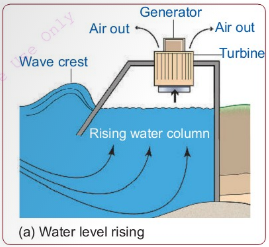 | 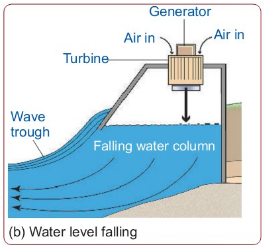 |
| Figure 3: Electric generation from ocean waves | |
Generating electricity using water currents
Water currents caused by ocean tides can generate electric energy- The energy is generated by a specialized plant whose principle for the generation Of electricity is shown in Figure Basically, this plant is similar to the one that generates electricity from a waterfall.
 (a) High tide |
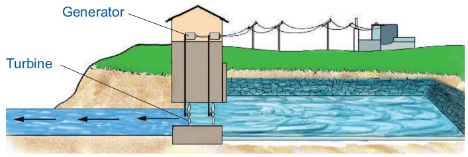 (b) Low tide |
Figure 4: Tidal power plant
As the arrows in Figure 4 (a) shown during a high tide, water flows out Of the ocean and passes through the turbines before entering the dam. During a low tide, the water that entered the dam flows back to the ocean as the arrows in Figure 4 (b) Show, The water continues to rotate the turbines driving the generator that produces electricity High and low tides generate electricity using water currents,
Advantages of generating electricity from water waves and currents
(a) The electricity generated from ocean currents is always available provided there is a large water reserving darn r
(b) The electricity generated from water waves and currents is renewable. This is because the tides are due to the natural forces, which are always available,
(c) The electricity produced from water waves and currents is environmentally friendly- This is because its generation does not produce harmful gases to living organisms.
Disadvantages Of generating electricity from water waves and currents
(a) This method of generating electricity is not used in most countries. This is because the initial costs associated with the manufacturing and installation of the plant are high.
(b) Living organisms in the ocean can be affected if they are not prevented from entering the turbine area by wire mesh.
Exercise
Answer the following questions:
1. Explain the sources of water waves.
2. List the main components Of a power plant that generates electricity from ocean water waves.
3. Describe how to generate electricity from water waves,
4. Describe how to generate electricity from ocean water currents.
The concept of geothermal energy
Geothermal energy comes from hot magma in the underground rocks. Sometimes magma can flow as lava through cracks in rocks, causing a volcano. However, large amounts of magma remain in the underground rocks. Thus, the rocks and groundwater near the magma area heat up. In some places, water jets out to the earth's surface as vapour and hot spring. The steam and hot water in the rocks are the sources of geothermal energy that can be used to generate electricity. Geothermal energy is another source Of renewable energy.
Generating electricity from geothermal energy
Geothermal energy can be converted into electricity using a special electric generating plant. The plant consists of a turbine which is rotated by high pressure steam The steam 's pumped out from underground rocks as shown in Figure 5,
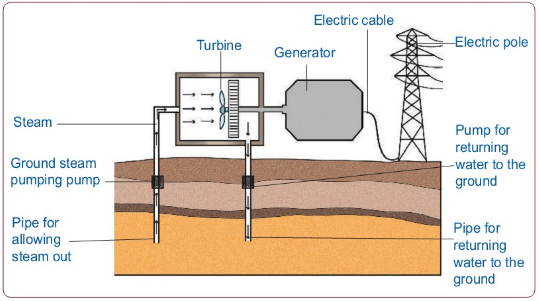 |
| Figure 5: Geothermal power plant for producing electricity |
The steam used to run the turbine cools, changes into liquid, and than returns back to the earth via a pump. The turbine is connected to the generator that produces electricity- This electricity is distributed using electric cables and poles.
Answer the following questions:
1. Explain the source of geothermal energy,
2. Why is geothermal energy renewable?
3. Describe how geothermal energy is used to generate electricity.
Advantages Of generating electricity from geothermal energy
(a) Geothermal electricity is renewable, and it cannot be depleted as its sources are sustainable.
(b) The running costs of electrical plants are low.
Disadvantages of generating electricity from geothermal energy
(a) The initial costs of manufacturing and installing electrical plants are high.
(b) Geothermal sources are found only in some areas. Hence, only few countries can benefit from it.
Quality of renewable energy
Renewable energy is a better source of energy than non-renewable energy. This energy is ideal as it comes from natural sustainable sources. For example, hydro-power from waterfalls or water stored in dams is cheaper due to the presence of sufficient water sources. Electrical energy from water waves can be used at any time in countries with coastlines like Tanzania.
Disadvantages Of renewable energy
Although renewable energy is better than non-renewable energy, it has the following disadvantages:
(a) Renewable energy involves large capital cost.
(b) Renewable energy depends on the presence and type Of a primary source For example, wind power depends on the presence of high speed Wind to generate electricity. Similarly, energy from waterfalls depends on the availability Of sufficient water.
Vocabulary
Geothermal : the heat in the underground rocks
Lava : magma that reaches the earth's surface through rock cracks
Magma : hot liquid or molten rock within the earth's surface
Undulating motion : up-and-down movement like the motion Of waves
Wave crest : the highest point the wave rises
Wave trough : the lowest point the wave falls
Answer all questions in Sections A, B and C.
Section A
Fill in the blanks.
1. The sources of renewable energy are . . . . . . . . . . and . . . . . . . . . . . . .
2. The sources of electricity derived from water are . . . . . . . . . . . . . and . . . . . . . . . . . . .
3, A power plant that does not use a turbine is . . . . . . . . . . . . .
Section B
Write TRUE for a correct statement and FALSE for an incorrect statement i in the space provided.
4. Electrical energy is generated using oil and biogas only.
5. Renewable energy resources are derived from natural processes.
6. Water waves, waterfalls, and geothermal energy are some of the sources for generating electricity.
7. Manufacturing and installation costs of renewable energy plants are '
8. Electrical energy from wind does not depend on the presence of high speed wind.
Section C
9. List two advantages of renewable energy
10. using examples, differentiate between renewable and non-renewable energies,
11. Differentiate between solar-generated electric energy and geothermal generated electric energy.
12. Renewable energy is called sustainable energy. Explain.
13. Which source is easier to generate electricity in your environment? Why?
14. Explain the advantages of the electrical energy generated by ocean waves.
www.learninghubtz.co.tz
Hub App
 For Call,Sms&WhatsApp: 255769929722 / 255754805256
For Call,Sms&WhatsApp: 255769929722 / 255754805256
 For Call,Sms&WhatsApp: 255769929722 / 255754805256
For Call,Sms&WhatsApp: 255769929722 / 255754805256
WHATSAPP US NOW FOR ANY QUERY
App Ya Learning Hub Tanzania






